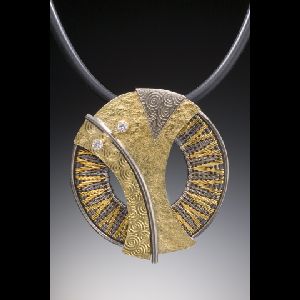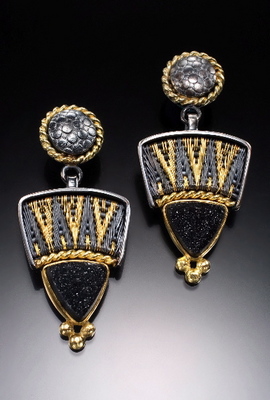 Sally Craig learned wire weaving in Seattle during the 1980s from a master, the amazing Mary Lee Hu, who encouraged her to pursue jewelry-making as a career.
Sally Craig learned wire weaving in Seattle during the 1980s from a master, the amazing Mary Lee Hu, who encouraged her to pursue jewelry-making as a career.
Craig did just that, but struggled to find a signature look. For many years, she had two separate lines: one of textured, mixed metals and the other of woven wire. Both revolved around geometric shapes and colored stones and she teetered between the two.
One day, a fellow jewelry artist suggested she try combining them. “It was like a light bulb going on,” Craig says. “It opened up a whole range of design possibilities.”
She began oxidizing the sterling to complement the high-karat gold in 2007. As soon as she debuted her new line, she knew she had a hit. Demand was so hot she phased out everything else to refine and expand the “black-and-gold,” as she calls it.
 In the process, she abandoned the colored stones that had been central to her jewelry. Somehow, nothing looked right against the charcoal gray of the oxidized sterling but black druzy, pearls and tiny diamond accents. “I love the sparkle of black druzy. It has so much life,” she says. “That blackened metal needs light and it needs a certain amount of gold.”
In the process, she abandoned the colored stones that had been central to her jewelry. Somehow, nothing looked right against the charcoal gray of the oxidized sterling but black druzy, pearls and tiny diamond accents. “I love the sparkle of black druzy. It has so much life,” she says. “That blackened metal needs light and it needs a certain amount of gold.”
One result of this monochromatic palette is to focus the eye on the rich interplay of textures. Woven sections are done by wrapping 22kt gold or sterling weft around 18kt gold or sterling warps. The textured metals are roller-pressed using pre-formed brass sheets with etched patterns she purchased eight years ago—and has almost worn down completely.
Craig credits Mary Lee Hu and and other teachers she studied with early on, including John Marshall and the late Earl Pardon, for inspiring her to become a jewelry artist. Two decades later, she is philosophical about her success. “All I can do is make jewelry that I like that I think other people will wear and collect,” she says. “I can’t always predict what will sell but I know when something is right.” You can find more jewelry by Sally Craig here.

